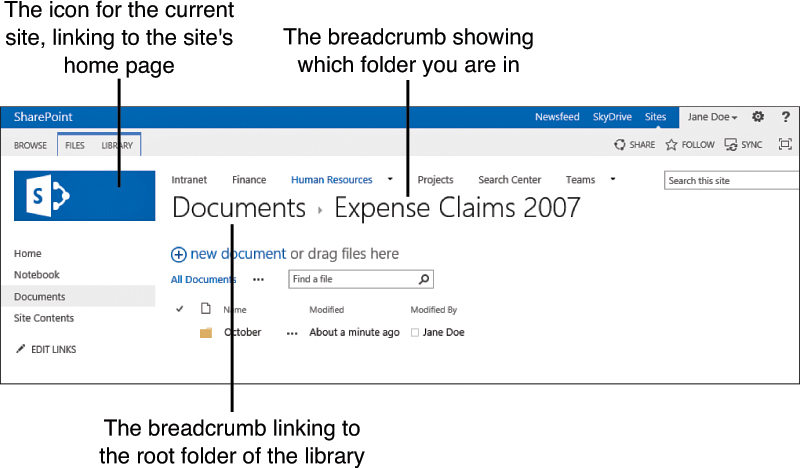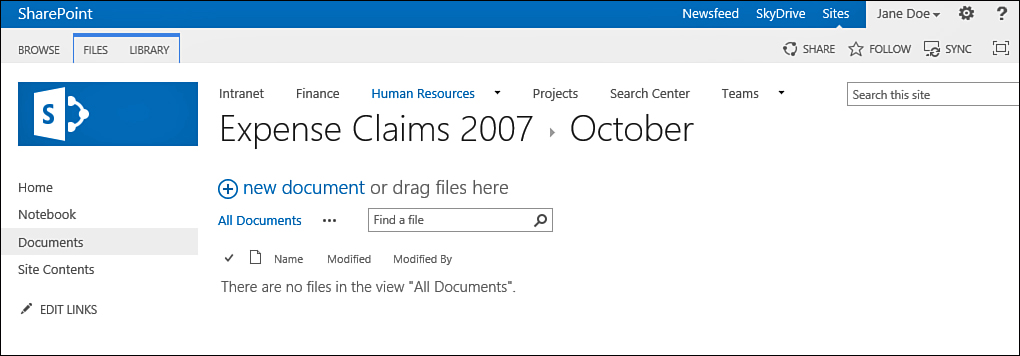Use the Breadcrumbs
The breadcrumbs mechanism is commonly used to
navigate websites. It shows you where you are in the site, so you can
go “up” the hierarchy all the way to the home page of the site. For
example, if you are viewing a folder in a document library, the
breadcrumbs will show you the list of folders that are above the
current folder, and then a link to the document library’s root folder
(as the name of the document library). To navigate back to the site’s
home page, you can click on the site’s logo or name, which is usually
to the left of the breadcrumbs (see Figure 4).
Depending on the site’s configuration, the breadcrumbs might start in
different places. By default the breadcrumbs in SharePoint 2013 show
you where you are within a folder structure (which is usually in a
document library).

FIGURE 4 The breadcrumbs navigation
interface for the Expense Claims 2007 folder in the Documents library
in the Expense Claims site under Human Resources.
In some cases (usually
with pages in pages libraries), the breadcrumbs do not show that the
page is under a library, but instead display as if the page is directly
under the site itself.
As you go deeper into the folder hierarchy,
the breadcrumbs by default show the parent folder of the one you are
in, allowing you to navigate up one folder at a time. For example, if
you navigate into the October folder shown in Figure 4—the
breadcrumbs then show the name of the current folder (October) preceded
by the name of the parent folder instead of the name of the library, as
shown in Figure 5.
Note that this is merely the default behavior, and it is possible for
your site designer to change the breadcrumbs to show more information
or behave differently.

FIGURE 5 The breadcrumbs in the October folder show the parent folder Expense Claims 2007.
To use the breadcrumbs, you just click on the link you want to navigate to.
Tip
When you’re in a document library
that has folders, using the breadcrumbs is the best way to go back to
the parent folder of the one you are currently in.
Use the Navigate Up Breadcrumbs
In addition to the navigation bars and the
breadcrumbs, SharePoint 2013 also has a button dedicated to navigation
called the Navigate Up button. Although this button is not available by
default, a site designer might enable it for you to use.
Note
By default, this button is not shown in the
SharePoint navigation—if you don’t see it, it is up to the site’s
designer to add it.
This button solves the problem of long
breadcrumbs. As mentioned earlier, if you are in a folder in a document
library with a lot of parent folders, the breadcrumbs might get too
long to display the entire hierarchy.
You can usually find the Navigate Up button in the top-left site of the top navigation bar (see Figure 6). It appears as a rectangular icon with a gray arrow pointing up. Clicking
on that button does not take you up but instead shows you a
hierarchical view of breadcrumbs—showing you where you are on the site
and allowing you to navigate up.

FIGURE 6 Using the Navigate Up button allows you to follow the breadcrumb trail all the way to the top site.
The Navigate Up breadcrumbs differ from the
normal breadcrumbs navigation mentioned in two
major ways. First, they show the entire hierarchy all the up to the
root site in the site collection, and not just to the current site. For
example, if you have a site called Expense Claims inside the Human
Resources site, the Navigate Up breadcrumbs show Human Resources above
Expense Claims in the hierarchy. Figure 6 shows the Navigate Up menu for the October folder shown in Figure 5.
Second, compared to the regular
breadcrumbs, the Navigate Up breadcrumbs offer more hierarchy detail
for pages. Unlike the breadcrumbs mentioned earlier, the Navigate Up
breadcrumbs display the entire hierarchy structure for the page you are
viewing. For example, if you are viewing a web part page in a pages
library, the normal breadcrumbs will show the site name as the parent
for the page, while the Navigate Up breadcrumbs show you the library
the page is in as the parent of the page. This allows you to go to the
library as well as to the site, but it can make the hierarchy in this
control very long if the page you are viewing is deep inside the
hierarchy.